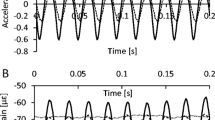Abstract
Although the skeleton's adaptability to load-bearing has been recognized for over a century1, the specific mechanical components responsible for strengthening it have not been identified. Here we show that after mechanically stimulating the hindlimbs of adult sheep on a daily basis for a year with 20-minute bursts of very-low-magnitude, high-frequency vibration, the density of the spongy (trabecular) bone in the proximal femur is significantly increased (by 34.2%) compared to controls. As the strain levels generated by this treatment are three orders of magnitude below those that damage bone tissue, this anabolic, non-invasive stimulus may have potential for treating skeletal conditions such as osteoporosis.

Similar content being viewed by others
References
Wolff, J. The Law of Bone Remodeling (transl. Maquet, P. & Furlong, R.) (Springer, Berlin, 1986).
Frost, H. Anat. Rec. 26, 403–413 (1990).
Burr, D., Martin, R., Schaffler, M. & Radin, E. J. Biomech. 18, 189–200 (1985).
Rubin, C. & Lanyon, L. J. Exp. Biol. 101, 187–211 (1982).
Schaffler, M., Radin, E. & Burr, D. Bone 11, 321–326 (1990).
Huang, R., McLeod, K. & Rubin, C. J. Gerontol. 54, 352–357 (1999).
Fritton, J., Rubin, C., Qin, Y. & McLeod, K. Ann. Biomed. Eng. 25, 831–839 (1997).
Carter, D., Harris, W., Vasu, R. & Caler, W. Am. Soc. Mech. Eng. 45, 81–95 (1981).
Hylander, W., Ravosa, M., Ross, C. & Johnson, K. Am. J. Phys. Anthropol. 107, 257–271 (1998).
Blob, R. & Biewener, A. J. Exp. Biol. 202, 1023–1046 (1999).
Fritton, S., McLeod, K. & Rubin, C. J. Biomech. 33, 317–326 (2000).
Bain, S. & Rubin, C. J. Bone Miner. Res. 5, 1069–1075 (1990).
Rubin, C., Gross, T., McLeod, K. & Bain, S. J. Bone Miner. Res. 10, 488–495 (1995).
Author information
Authors and Affiliations
Corresponding author
Rights and permissions
About this article
Cite this article
Rubin, C., Turner, A., Bain, S. et al. Low mechanical signals strengthen long bones. Nature 412, 603–604 (2001). https://doi.org/10.1038/35088122
Issue Date:
DOI: https://doi.org/10.1038/35088122
- Springer Nature Limited
This article is cited by
-
The effect of low-intensity whole-body vibration with or without high-intensity resistance and impact training on risk factors for proximal femur fragility fracture in postmenopausal women with low bone mass: study protocol for the VIBMOR randomized controlled trial
Trials (2022)
-
Three-dimensional imaging and molecular analysis of the effects of photobiomodulation and mechanical vibration on orthodontic retention treatment in rats
Journal of Orofacial Orthopedics / Fortschritte der Kieferorthopädie (2022)
-
Effects of Whole-Body Vibration on Breast Cancer Bone Metastasis and Vascularization in Mice
Calcified Tissue International (2022)
-
Finite Element Models of Osteocytes and Their Load-Induced Activation
Current Osteoporosis Reports (2022)
-
Protective effects of low-magnitude high-frequency vibration on high glucose-induced osteoblast dysfunction and bone loss in diabetic rats
Journal of Orthopaedic Surgery and Research (2021)





